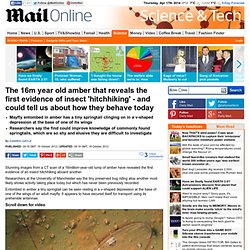

7 million year old fossil of elephant ancestor is found in east Romanian village Scientists discovered bone fragments in a village in eastern Vaslui county They unearthed a jaw bone, leg bones, pelvis fragments and nine teethThe ancestor of the African elephant would have stood at five-metres tallThe Deinotherium giganteum lived around seven million years ago By Imogen Calderwood For Mailonline Published: 13:33 GMT, 28 June 2015 | Updated: 13:33 GMT, 28 June 2015 Bone fragments from an ancestor of the African elephant have been unearthed in a village in east Romania.

The creature lived around seven million years ago, and stood at around five metres tall and between three and four metres long. Named the Deinotherium giganteum - meaning 'terrible beast' in Greek - the animal would have lived in the Moldova plateau, which spreads across northeastern Romania, most of Moldova and parts of Ukraine. Dolphins swam oceans six MILLION years earlier than originally thought, ancient skull reveals. Studies of a skull fragment have revealed it to be from an ancient dolphinResearch was led by Mizuki Murakami of the Waseda University in JapanThe fossil was first found in 1970 but its origin has only just been revealedIt belonged to a species of dolphin that existed up to 13 million years agoThe finding makes dolphins 6 million years older than previously thoughtNames Eodelphis kabatensis the species is an important evolutionary link By Jonathan O'Callaghan Published: 16:32 GMT, 6 May 2014 | Updated: 13:49 GMT, 8 May 2014 Dolphins may have been swimming the Earth’s oceans for six million years longer than previously thought, suggests a new study.

They are the most diverse family of living marine mammals and include species such as the bottlenose dolphin and the killer whale. However, their early evolution and fossil record has been steeped in mystery due to lack of good specimens. Rhino cooked to death: Young rhino torn asunder by pyroclastic flows 9.2m years ago found in Turkey. Preserved skull belonged to young adult two-horned rhino aged 10 to 15Fossil features suggest animal was baked to death in Pompeii-like eruptionLess than 2 per cent of the Earth's fossils are found in volcanic rock By Damien Gayle Published: 10:57 GMT, 27 November 2012 | Updated: 11:20 GMT, 27 November 2012.

Rhino 'Cooked to Death' 9 Million Years Ago, Fossil Reveals. About 9.2 million years ago, a teenage two-horned rhinoceros was literally cooked to death when a Mt.

Vesuvius-like eruption enveloped it in lava reaching more than 750 degrees Fahrenheit (400 degrees Celsius), scientists say. The perhaps fortunate result: a well-preserved skull of the Rhinocerotid, with a tale to tell. An analysis of the volcanic rock-preserved skull suggests the animal's grisly death was near instantaneous. "[T]he body was baked under a temperature approximating 400°C, then dismembered within the pyroclastic flow, and the skull separated from body," the researchers wrote online Nov. 21 in the journal PLoS ONE. The flow of volcanic ash carried the detached skull about 19 miles (30 kilometers) north of the eruption site and to the site where it was discovered in Cappadocia in Central Turkey.
Here, the cranium and mandible of the rhino are shown as they may have appeared when the animal was alive some 9.2 million years ago. The so-called Çardak caldera is inactive today. The 16m year old amber that reveals the first evidence of insect 'hitchhiking' Mayfly entombed in amber has a tiny springtail clinging on in a v-shaped depression at the base of one of its wingsResearchers say the find could improve knowledge of commonly found springtails, which are so shy and elusive they are difficult to investigate By Damien Gayle Published: 09:18 GMT, 18 October 2012 | Updated: 09:18 GMT, 18 October 2012 Stunning images from a CT scan of a 16million-year-old lump of amber have revealed the first evidence of an insect hitchhiking aboard another.

Researchers at the University of Manchester say the tiny preserved bug riding atop another most likely shows activity taking place today but which has never been previously recorded. 7 Million-Year-Old Elephant Herd Revealed in Prints. The most extensive set of fossilized mammal footprints ever found has allowed scientists to recreate how elephants lived 7 million years ago.

The footprints were discovered at a site called Mleisa 1 in the United Arab Emirates. The find was reported in a new study in the journal Royal Society Biology Letters. NEWS: Footprints Show How Our Ancestors Walked Co-author Brian Kraatz told Discovery News that the trackway "shows the oldest evidence of complex social behavior within elephants. " "It's an amazing locality," added Kraatz, who is an assistant professor in the Department of Anatomy at the Western University of Health Sciences. "Basically, this is fossilized behavior," Faysal Bibi, lead author and a researcher at the Institut International de Paléoprimatologie and the Museum für Naturkunde, was quoted as saying in a press release. Bibi, Kraatz and their colleagues can tell that the prehistoric elephant herd consisted of at least 13 individuals.